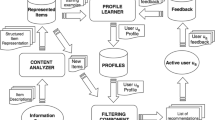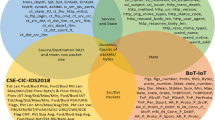Abstract
IPTV has emerged as one of the popular Internet applications attracting immense interest of academia and industry. Among others, Peer-to-Peer (P2P) approach enables IPTV service with ease of deployment and low cost. P2P systems involve end-hosts, called peers, to share their resources for dissemination of stream. In these systems, user activities, such as join and quit operations, translate as activities of peers. Due to this reason, these systems become highly dynamic as the behavior of users has a significant impact on the stream delivery performance of the whole system. Earlier P2P approaches deal with user behavior indirectly through enabling resilience in the system, which leads to other issues such as increased latency. Latter approaches attempt to address user behavior directly through proposing user behavior models. Such models focus to learn and predict user behavior in order to adapt the overlay network accordingly. Towards this, one important aspect is the classification of users. However, machine-learning classifiers have not been extensively evaluated for their accuracy over the classification problem. In this paper, we extensively evaluate numerous classifiers for their accuracy over different parameters. These results may be used to design intelligent P2P overlays for IPTV services providing better performance in terms of efficient stream delivery to users. Our results show that the Decision tree classifier performs better than other classifiers for this particular problem.







Similar content being viewed by others
References
Almeroth KC (2000) The evolution of multicast: from the mbone to interdomain multicast to internet2 deployment. IEEE Netw 14(1):10–20
Stocker V, Smaragdakis G, Lehr W, Bauer S (2017) The growing complexity of content delivery networks: Challenges and implications for the internet ecosystem. Telecommun Policy 41(10):1003–1016
Pal K, Govil MC, Ahmed M (2019) FLHyO: fuzzy logic based hybrid overlay for p2p live video streaming. Multimed Tools Appl 78:33679–33702
Ullah I, Doyen G, Bonnet G, Gaïti D (2012) A survey and synthesis of user behavior measurements in video streaming systems. IEEE Commun Surv Tutorials 14(3):734–749
Ullah I, Doyen G, Bonnet G, Gaïti D (2011) User behavior anticipation in P2P live video streaming systems through a Bayesian network. In: IM pp. 337–344
Liu Z, Wu C, Li B, Zhao S (2009) Distilling superior peers in large-scale P2P streaming systems. In: IEEE INFOCOM pp. 82–90
Wehner N, Seufert M, Egger-Lampl S, Gardlo B, Casas P, Schatz R (2020) Scoring High: Analysis and Prediction of Viewer Behavior and Engagement in the Context of 2018 FIFA WC Live Streaming. Association for Computing Machinery pp. 807–815
Merani ML, Natali L, Barcellona C (2016) An ip-tv p2p streaming system that improves the viewing quality and confines the startup delay of regular audience. Peer Peer Netw Appl 9(1):209–222
Kim E, Kim J, Lee C (2019) Efficient neighbor selection through connection switching for p2p live streaming. J Ambient Intell Humaniz Comput 10:1413–1423
Gao Y, Wei X, Zhang G, Zhou L, Dong Z (2018) Mining iptv user behaviors with an enhanced lda model. In: 2018 IEEE Global Communications Conference (GLOBECOM) pp. 1–6
Ooka R, Miyoshi T, Yamazaki T (2019) Unit traffic classification and analysis on p2p video delivery using machine learning. IEICE Commun Express 8(12):640–645
Labayen V, Magana E, Morato D, Izal M (2020) Online classification of user activities using machine learning on network traffic. Comput Netw 181:107557
Ma W, Zhang Q, Mu C, Zhang M (2019) QoS Prediction for Neighbor Selection via Deep Transfer Collaborative Filtering in Video Streaming P2P Networks. Int J Digit Multimed Broadcast 2019:1–10
Sina M, Dehghan M, Rahmani AM (2019) Cloud-assisted reinforcement learning based p2p live video streaming: a hybrid approach. Multimed Tools Appl 78:34095–34127
Basicevic I, Kukolj D, Ocovaj S, Cmiljanovic G, Fimic N (2018) A fast channel change technique based on channel prediction. IEEE Trans Consum Electron 64(4):418–423
Ghaderzadeh A, Kargahi M, Reshadi M (2018) Redepoly: reducing delays in multi-channel p2p live streaming systems using distributed intelligence. Telecommun Syst 67(2):231–246
Yang C, Ren S, Liu Y, Cao H, Yuan Q, Han G (2018) Personalized channel recommendation deep learning from a switch sequence. IEEE Access 6:50824–50838
Budhkar S, Tamarapalli V (2020) An overlay management strategy to improve qos in cdn-p2p live streaming systems. Peer-to-Peer Netw Appl 13:190–206
Tang Y, Sun L, Zhang K, Yang SQ, Zhong Y (2007) Longer, better: On extending user online duration to improve quality of streaming service in P2P networks. In: IEEE International Conference on Multimedia and Expo pp. 2158–2161
Wang F, Xiong Y, Liu J (2007) mTreebone: A hybrid tree/mesh overlay for application-layer live video multicast. In: \(27^{th}\) International Conference on Distributed Computing Systems p. 49
Bonnet G, Ullah I, Doyen G, Fillatre L, Gaïti D, Nikiforov I (2011) A Semi-Markovian individual model of users for P2P video streaming applications. In: \(4^{th}\) IFIP International Conference on New Technologies, Mobility and Security (NTMS). IEEE pp. 1–5
Liu Z, Wu C, Li B, Zhao S (2009) Distilling superior peers in large-scale P2P streaming systems. In: Proceedings of INFOCOM pp. 82–90
Brampton A, MacQuire A, Rai I, Race NJP, Mathy L, Fry M (2007) Characterising user interactivity for sports video-on-demand. In: Proceedings of the 17th NOSSDAV
Yu H, Zheng D, Zhao BY, Zheng W (2006) Understanding user behavior in large-scale video-on-demand systems. Oper Syst Rev 40(4):333–344
Rudstrom A, Sjolinder M (2008) Capturing TV user behaviour in fictional character descriptions. Tech. rep, SICS
Maimon O, Rokach L (2010) Data Mining and Knowledge Discovery Handbook, 2nd edn. Springer Publishing Company, Incorporated
Lejarraga T, Dutt V, Gonzalez C (2012) Instance-based learning: A general model of repeated binary choice. J Behav Decis Mak 25(2):143–153
Lee S, Choeh JY (2014) Predicting the helpfulness of online reviews using multilayer perceptron neural networks. Expert Syst Appl 41(6):3041–3046
Funding
The authors received no specific funding for this work.
Author information
Authors and Affiliations
Corresponding author
Ethics declarations
Conflicts of interests
The authors declare that they have no competing or conflicting interests to report regarding this work.
Additional information
Publisher’s Note
Springer Nature remains neutral with regard to jurisdictional claims in published maps and institutional affiliations.
Rights and permissions
About this article
Cite this article
Ali, M., Asghar, R., Ullah, I. et al. Towards intelligent P2P IPTV overlay management through classification of peers. Peer-to-Peer Netw. Appl. 15, 827–838 (2022). https://doi.org/10.1007/s12083-021-01288-y
Received:
Accepted:
Published:
Issue Date:
DOI: https://doi.org/10.1007/s12083-021-01288-y




